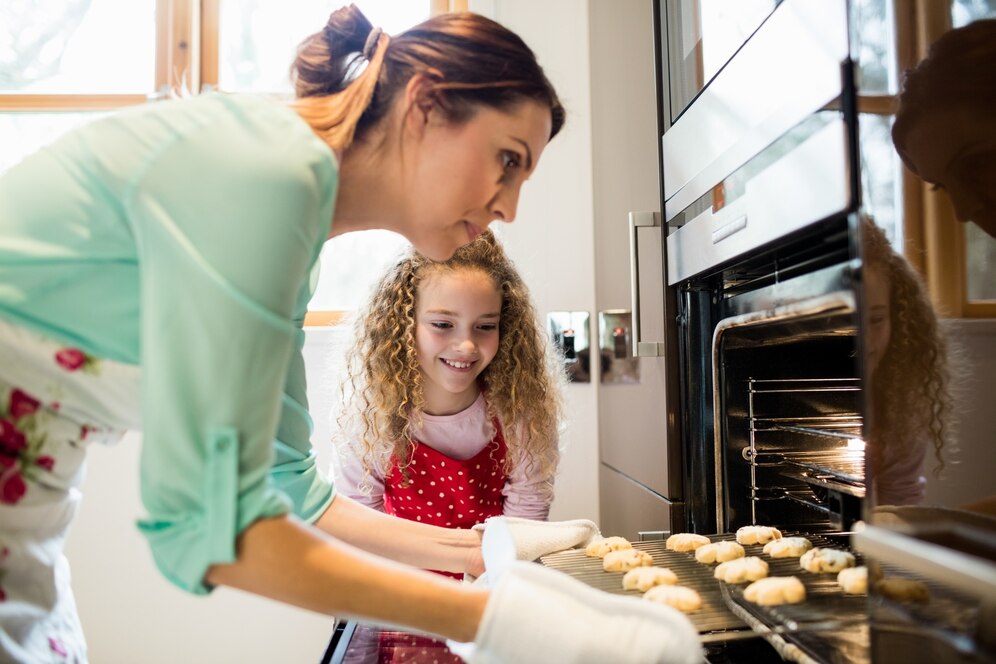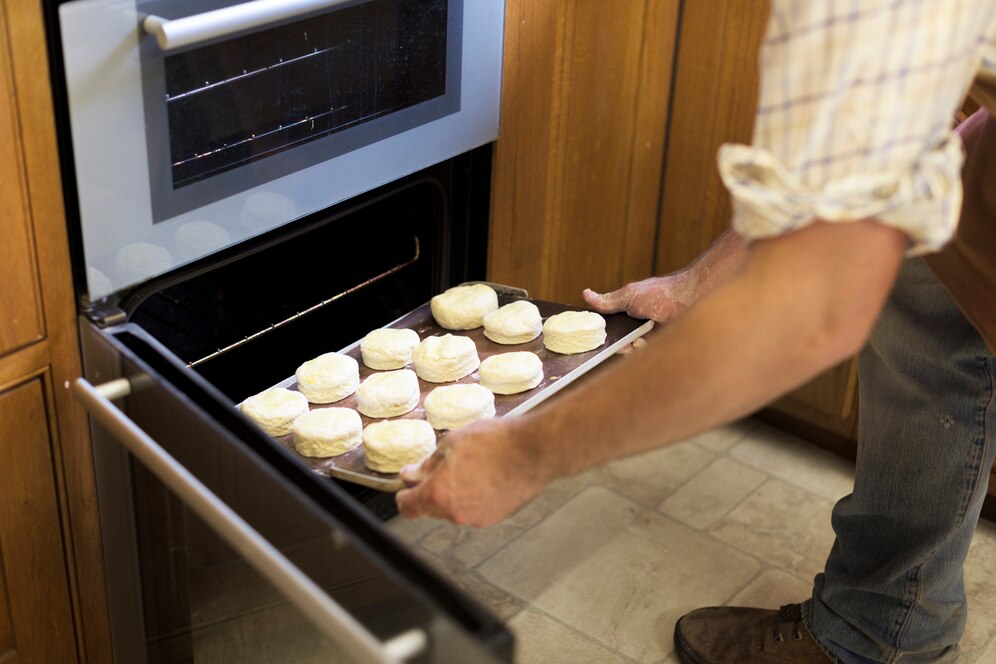Maximizing Your Oven’s Potential: A Guide to Better Baking
 Are you frustrated with your oven’s baking performance? Is it not giving you the perfect, evenly baked treats that you desire? Don’t worry, you’re not alone.
Are you frustrated with your oven’s baking performance? Is it not giving you the perfect, evenly baked treats that you desire? Don’t worry, you’re not alone.
Many homeowners struggle with their oven’s baking performance and end up constantly adjusting temperature settings or even resorting to buying a new one. However, before you spend money on a new oven, there are some simple steps you can take to maximize your oven’s baking performance.
From regular cleaning to oven repairs, the steps this article will cover should help you keep your oven in great condition. So let’s turn up the heat and get started!
- Clean Your Oven Regularly
- Check the Door Seal
- Use Quality Bakeware
- Preheat Your Oven
- Don’t Overcrowd Your Oven
- Utilize the Right Rack Position
- Consider Using an Oven Thermometer
- Schedule Regular Maintenance
1. Clean Your Oven Regularly
Believe it or not, one of the most common reasons for poor baking performance is a dirty oven. Food residue, spills, and crumbs don’t only affect the appearance of your oven, these residues can absorb heat, leading to uneven cooking, or even produce smoke that can alter the flavor of your food.
Regular cleaning also extends the lifespan of your oven and helps avoid costly repairs down the line. It’s recommended to give your oven a thorough clean at least once every three months, or more frequently depending on usage. Using non-abrasive cleaners or a simple mixture of baking soda and vinegar can effectively remove grime without damaging your oven’s interior.
2. Check the Door Seal
A faulty door seal can also affect your oven’s baking performance. The door seal, often a rubber gasket that runs along the oven door, plays a vital role in maintaining the oven’s heat. Over time, this gasket may wear down, leading to heat escaping during the cooking process, which can result in uneven baking and increased energy use.
To check the door seal, you can conduct a simple test like the Deli Paper Test. If the paper can be pulled out with little or no resistance, the gasket might be loose and need adjustment or replacement. Keeping the door seal clean and free from debris also contributes to a well-sealed oven door. A damaged or torn gasket should ideally be serviced by an appliance repair company.
3. Use Quality Bakeware
The type of bakeware you use can also impact your oven’s baking performance. Keep these tips in mind when selecting your bakeware:
- Metal pans are excellent conductors of heat and yield a beautifully browned crust.
- Glass or ceramic dishes, on the other hand, are slower to heat but provide consistent, even baking, making them ideal for dishes that require slow cooking.
- Darker pans absorb more heat than lighter ones, so adjusting the oven temperature accordingly can prevent over-browning.
- Worn-out, warped, or scratched bakeware can lead to uneven baking.
Maintaining your bakeware in good condition and choosing the right type for your baking needs will ensure that your oven operates at its optimum efficiency.
4. Preheat Your Oven
Always preheat your oven before baking. This allows the oven to reach the desired temperature and ensures that your food is cooked evenly. Failure to preheat can result in under or overcooked food.
Preheating is especially critical for foods that need a certain level of heat to properly rise, crisp, or brown. Additionally, preheating helps food go from refrigerator cold to blazing hot more quickly, minimizing the time spent in the temperature danger zone and promoting food safety. Skipping this step might seem like a time-saver, but it can lead to longer cooking times and unevenly cooked food.
5. Don’t Overcrowd Your Oven
Another common mistake is overcrowding your oven. Overcrowding can lead to uneven cooking, as it prevents heat from circulating evenly around the food. When too many dishes are placed in the oven simultaneously, they may touch or overlap, causing a release of excess moisture that could prevent food from browning.
A good rule of thumb is to ensure there’s enough space for adequate airflow between dishes. This means leaving at least one inch between items and never covering more than about half the surface area of your oven rack. Overcrowding can also cause food to steam rather than sear, preventing a proper caramelized crust from forming.
6. Utilize the Right Rack Position
Different recipes may call for different rack positions in the oven. The placement of the rack within the oven can greatly influence the cooking process of your food due to the varying heat distribution. Typically, for most foods the middle rack is best. However, for specific types of cooking, situating your dish on the top or bottom rack closest to the heating element might yield better results.
For instance, the top rack is ideal for browning, while the bottom rack is great for dishes that need intense heat from below. Most ovens have two racks with four or five different positions for placement, providing flexibility based on your specific baking needs.
7. Consider Using an Oven Thermometer
 Sometimes ovens can have inaccurate temperature readings, which can affect baking performance. While most ovens come with built-in thermostats, they can often be inaccurate, leading to inconsistent cooking results.
Sometimes ovens can have inaccurate temperature readings, which can affect baking performance. While most ovens come with built-in thermostats, they can often be inaccurate, leading to inconsistent cooking results.
Oven thermometers are independent devices that measure the exact temperature inside the oven. By using one, you can ensure your oven is truly at the temperature you set it to. They’re particularly useful when baking sensitive items like cakes or pastries, where a few degrees can make a difference between success and failure.
Oven thermometers are generally inexpensive and easy to use, making them a valuable tool for anyone looking to optimize their baking performance. Just remember to place it in a spot where you can easily read it without opening the oven door.
8. Schedule Regular Maintenance
Just like any other appliance, your oven needs regular maintenance to ensure it is functioning at its best. Schedule annual maintenance checks and repairs when needed with a professional appliance repair company like Comfort Appliance Repair.
Comfort Appliance Repair offers the best in Atlanta oven repair. We can help identify any issues with your oven, stove, and any major appliance, to keep your appliance in its best shape. Call Comfort Appliance if you are having issues with your oven. We are here to help!
By Dennis Godynuk, Owner of Comfort Appliance Repair
Dennis Godynuk is the owner of Comfort Appliance Repair in Covington, GA. Comfort Appliance provides fast and reliable repair services for all major household appliances. Dennis and his team of experienced technicians can tackle any problem, from broken refrigerators to malfunctioning dishwashers, and their prices are very competitive. Customers can rest easy knowing that their appliances are in good hands when they call Comfort Appliance Repair.



